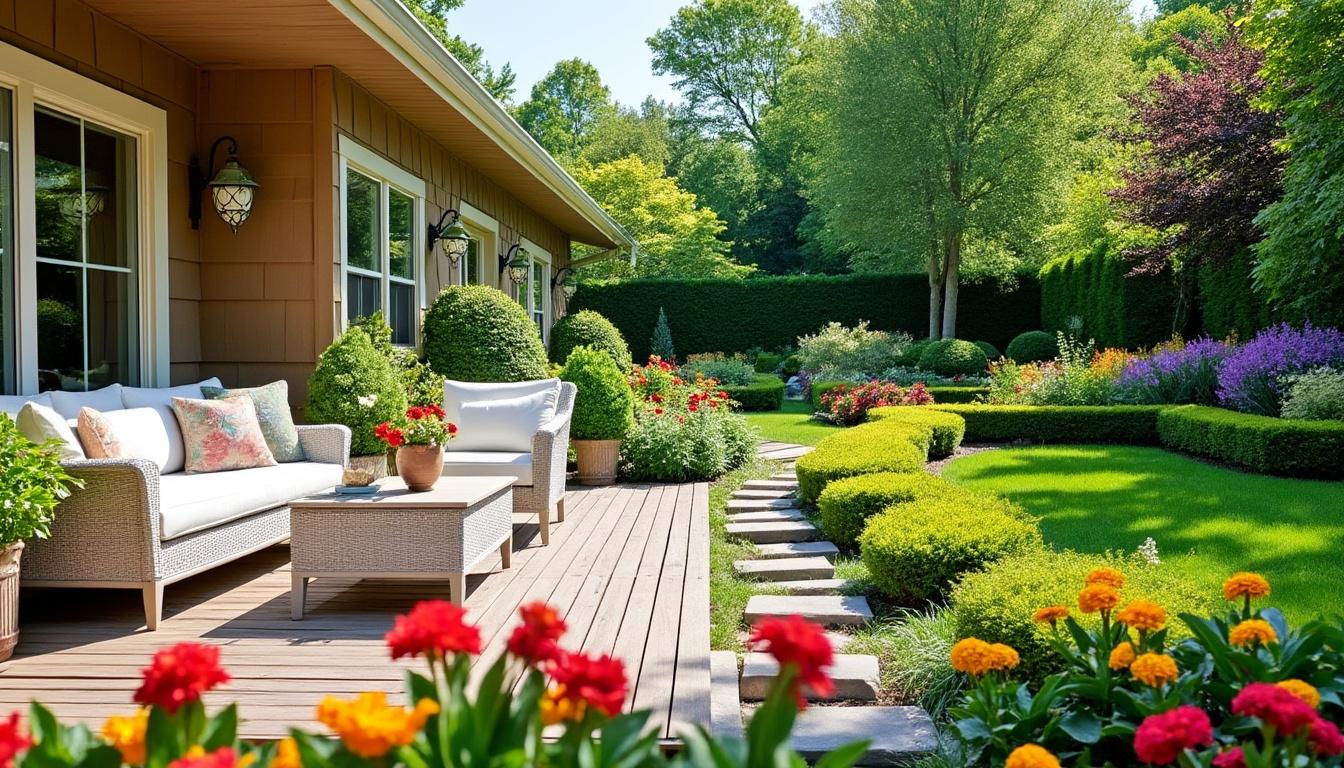Transforming an outdoor space into a personal garden sanctuary requires more than just planting flowers and placing furniture randomly. Attention to detail, strategic planning, and a clear understanding of the area’s potential can set a garden apart as a place of serenity, entertainment, and aesthetic value. As demand grows for outdoor living environments that blend function and style, homeowners turn to retailers like Home Depot, Lowe’s, and IKEA to source the best materials and décor, while leveraging expert landscaping guidance to tailor unique garden spaces. Whether you are redesigning a sprawling backyard or optimizing a compact urban plot, the following tips are essential for any successful garden development project.
Assessing Your Outdoor Space For Effective Garden Planning
Understanding the specific characteristics of your outdoor space is the foundational step in any garden transformation. Factors such as climate, soil type, sunlight exposure, and existing vegetation significantly impact which plants will thrive and how the garden should be organized. For example, a garden receiving full sun requires drought-resistant and heat-tolerant plants from suppliers like Burpee or Gardener’s Supply Company, while shaded areas benefit from foliage and flower varieties that flourish in low light.
Planning begins with meticulous site analysis:
- Soil Testing: Determine pH levels and nutrient content to decide if amending the soil is necessary.
- Sunlight Mapping: Track sunlight patterns at different times of the day and seasons to select appropriate plant species.
- Drainage Assessment: Identify water accumulation zones to effectively position plants that prefer moist or dry conditions.
Additionally, considering the local climate and average rainfall helps forecast maintenance intensity. Engaging with local garden centers such as Terrain or Green Thumb provides access to region-specific advice and products, ensuring your selections are well-suited for long-term sustainability.
Creating a Functional Layout That Enhances Usability
Effective garden planning involves more than aesthetics—it prioritizes functional zones for relaxation, socializing, and horticultural activities. A well-thought-out layout incorporates a balance between green areas and walkways, seating spots, and possibly outdoor kitchens or fire pits. Retailers like Wayfair and Best Buy offer an extensive range of outdoor furniture and smart lighting solutions customizable to any layout.
Key considerations in layout design include:
- Define separate zones: dining, lounging, planting, and play areas for families with children.
- Ensure smooth traffic flow between zones to avoid crowding or wasted space.
- Use natural features such as slopes or existing trees to integrate elements organically.
- Plan furniture placements that maximize comfort and aesthetics while maintaining clear walkways.
Combining practicality with style transforms the outdoor space into a versatile extension of the home, encouraging more frequent use and enjoyment. For innovative ideas on spatial optimization, specialists often recommend exploring compact garden inspirations to maximize every square foot effectively.
| Area Consideration | Purpose | Recommended Features |
|---|---|---|
| Dining Zone | Meals and gatherings | Weather-resistant table, retractable awnings |
| Lounge Spot | Relaxation and reading | Comfortable seating, soft lighting, side tables |
| Planting Area | Gardening and cultivation | Raised beds, irrigation system |
| Play Area | Children’s safety and fun | Rubber flooring, secure fencing |
Enhancing Sustainability Through Thoughtful Plant Selection
In 2025, with a growing emphasis on eco-friendly gardening, sustainable plant choices have become crucial. Opting for native or drought-resistant species reduces water consumption and maintenance efforts while supporting local ecosystems. Companies such as Burpee and Gardener’s Supply Company provide a vast selection of seeds and starter plants suited for sustainable gardening.
Avoiding invasive species also protects biodiversity, and integrating a mix of perennials and annuals creates year-round interest and resilience. Companion planting techniques may also help reduce pests naturally without relying on chemical pesticides.
- Select plants acclimated to local climate conditions to ensure high survival rates.
- Incorporate pollinator-friendly plants to attract bees, butterflies, and birds.
- Use mulches and organic compost to improve soil fertility naturally.
- Set up rainwater harvesting or drip irrigation to optimize water use.
Utilizing Outdoor Living Enhancements To Maximize Garden Enjoyment
Transforming a garden into an outdoor living space demands attention to comfort and entertainment elements. As outdoor living trends expand, integrating fire pits, pergolas, or even outdoor kitchens from retailers such as Home Depot and Lowe’s elevates the functionality of the garden. Smart outdoor lighting solutions from Best Buy further enhance ambiance and security.
Maximizing garden usability involves layering elements tactically:
- Install adjustable lighting for versatility ranging from soft evening glows to bright task illumination.
- Position seating around focal points like fire pits or water features for social cohesion.
- Consider weather protection elements like retractable canopies or shade sails.
- Use garden paths to create natural transitions between functional zones, enhancing flow.
This holistic approach not only boosts property value but also creates inviting spaces for year-round use, whether hosting social events or enjoying quiet moments outdoors. Detailed guides such as those on maximizing summer garden potentials provide actionable instructions to leverage seasonal changes and garden resources optimally.
Incorporating Technology For Smarter Garden Maintenance
Advancements in smart home technology now extend deeply into gardening and outdoor care. Automated irrigation systems synchronized with weather forecasting apps, smart pest sensors, and robotic lawn mowers simplify routine maintenance dramatically. These technologies, often sourced from brands available at stores like Lowe’s or specialized outlets, save time while enhancing plant health.
Key tech features to consider include:
- Weather-based irrigation timers that adjust watering according to rainfall.
- Soil moisture sensors providing real-time data for targeted watering.
- Smart lighting controls allowing automated schedules for safety and ambience.
- Robot lawnmowers programmed for specific zones and avoidance of obstacles.
Smart solutions also reduce overwatering and chemical use, aligning with sustainable garden practices. Staying updated with the latest upgrades and following resources like green drenching gardening tips is recommended to keep the garden flourishing.
Practical Plant Care And Seasonal Maintenance Strategies For Lasting Beauty
Long-term garden success hinges upon consistent care protocols, adjusted seasonally to fit plant needs and environmental changes. Deadheading, pruning, fertilizing, and pest management each play vital roles in maintaining garden vigor. For comprehensive plant care methods, sources such as expert deadheading tips offer detailed guidance.
Seasonal maintenance breakdown:
- Spring: Focus on planting, pruning dead branches, and soil enrichment.
- Summer: Monitor watering needs carefully and control insect pests organically.
- Autumn: Prepare plants for dormancy, mulch beds, and clear fallen leaves.
- Winter: Protect sensitive species, plan for next season’s planting.
| Season | Key Tasks | Tools & Supplies |
|---|---|---|
| Spring | Pruning, planting, soil testing | Pruners, fertilizers, soil kits (available at Home Depot) |
| Summer | Watering, pest management, deadheading | Watering systems, organic pesticides |
| Autumn | Mulching, leaf clearing, plant protection | Mulch, rakes, plant covers |
| Winter | Plant care planning, protective covers | Protective textiles, gardening catalogs (from Terrain) |
Such regularly scheduled maintenance not only supports plant health but also sustains the overall garden aesthetic and functionality throughout the year.
Creative Strategies To Enhance Year-Round Garden Interest
To sustain longer garden enjoyment, incorporating structures and plant selections with seasonal appeal is advantageous. Evergreens, flowering bulbs in winter, and deciduous trees with brilliant fall colors ensure visual interest beyond typical gardening periods. Additionally, utilizing fire pits or heated seating areas prolongs outdoor usability during colder months.
- Plant a mixture of perennials and annuals with staggered bloom times.
- Add ornamental grasses to provide texture and movement.
- Include decorative stone or wood elements for contrast and durability.
- Plan for winter interest through strategic plantings and garden accessories.
Incorporating Expert Resources And Networking For Garden Success
Garden transformation gains momentum through expert advice and community engagement. Collaborating with local landscaping professionals or participating in gardening workshops can provide personalized support. Retailers such as Gardener’s Supply Company and Burpee often host seminars or provide extensive online resources to guide enthusiasts.
Joining gardening clubs or online forums delivers additional benefits:
- Opportunities to exchange tips and experiences with other gardeners.
- Access to rare plant varieties and seeds from sources like Terrain.
- Staying updated on the latest garden design trends and innovations.
- Support for sustainable and wildlife-friendly gardening practices.
For inspiration and practical ideas, consulting articles dedicated to garden optimization frequently proves invaluable, such as compact garden ideas or timeless garden design tips. These resources ensure your outdoor space reflects your lifestyle while embracing ecological responsibility.
| Resource | Type | Benefits |
|---|---|---|
| Gardener’s Supply Company | Retailer and Advisory | Plant varieties, gardening tools, expert advice |
| Burpee | Seeds and Plants Supplier | Wide selection of plants, sustainability focus |
| Terrain | Online and Physical Retail | Garden décor, workshops, seasonal guides |
| Local Gardening Clubs | Community Groups | Networking, knowledge sharing, rare plant access |
Frequently Asked Questions About Planning Your Next Garden
- What are key criteria for selecting plants for a new garden?
Choosing plants requires considering local climate, soil conditions, sunlight exposure, and maintenance needs to ensure sustainability and visual appeal. - How can I create a garden layout that balances beauty and functionality?
Defining zones for different activities, ensuring fluid traffic flow, and selecting appropriate furniture placements provide balance between aesthetics and practicality. - What smart gardening technologies are worth investing in?
Automated irrigation timers, soil moisture sensors, and robotic mowers help save time, optimize resources, and maintain plant health with minimal effort. - How do I maintain a garden throughout the seasons?
Adhering to seasonal tasks such as pruning in spring, watering in summer, mulching in autumn, and protective measures in winter keeps the garden thriving year-round. - Where can I find reliable gardening advice and supplies?
Trusted retailers like Home Depot, Lowe’s, Gardener’s Supply Company, and online resources such as Daily Bakersfield News Gardening Tips offer comprehensive support and products.

